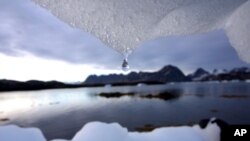Worried about climate change? This isn't your week.
In a consequential pairing of bad news, scientists have released new information showing a record rise in sea levels, and record high temperatures in the Arctic in January.
The researchers who looked at sea levels were able to collect information going back 28 centuries. They found that sea levels are rising faster today than at any time over the past 3,000 years. The news was released Monday by the Proceedings of the National Academy of Sciences.
"The 20th century rise was extraordinary in the context of the last three millennia," said the paper's lead author, Robert Kopp from Rutgers University, "and the rise over the last two decades has been even faster."
Temperatures, sea levels
The best estimates show that temperatures around the globe have risen more than a half-degree Celsius since 1880. Scientists attribute most of that rise to human emissions into the atmosphere.
Stefan Rahmstorf, a professor of ocean physics and the paper's co-author, is from Potsdam Institute for Climate Impact Research in Germany. Rahmstorf says the water is only going to get higher.
"I think we can definitely be confident that sea level rise is going to continue to accelerate if there's further warming," he told the New York Times, "which inevitably there will be."
How much rise? The researchers say the Earth's sea level could rise more than a meter by the year 2100.
Thin ice in Arctic
In separate research, scientists from NASA and from the National Oceanic and Atmospheric Administration reported that global temperatures, which already made 2015 the hottest year ever recorded, were unusually high at the North Pole.
On average, the North was nearly 4 degrees Celsius higher in January than average temperatures between 1951 and 1980. To make matters more dire, the researchers already had reported a record low amount of sea ice up North. The National Snow and Ice Data Center says the amount of January sea ice is 644,000 square kilometers below average.
NOAA says the lack of sea ice is due in part to an unusually strong El Nino and something scientists called "The Blob." That's their name for an atypically warm expanse of water in the northern Pacific that has been keeping temperatures in an area millions of kilometers wide about 3 degrees warmer than usual.











